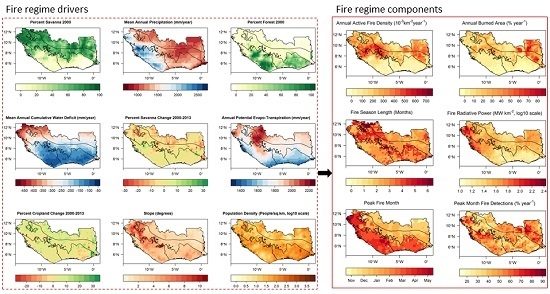Fire Regimes and Their Drivers in the Upper Guinean Region of West Africa
Abstract
:1. Introduction
- What are the spatial patterns and interrelationships of multiple fire regime components in the Upper Guinean region?
- What are the overall trends in fire activity and how do they differ amongst the humid forest and the savanna-dominated ecoregions?
- How do the relative influences of climate, topography, vegetation type, and human activity vary across different fire regime components?
2. Materials and Methods
2.1. Study Area
2.2. Remotely-Sensed Fire Data
2.2.1. Active Fires
2.2.2. Burned Area
2.3. Derived Fire Regime Variables
2.3.1. Active Fire Density
2.3.2. Annual Burned Area
2.3.3. Fire Season Characteristics
2.3.4. Mean Fire Radiative Power
2.4. Predictor Variables for Analyses of Fire Drivers
2.5. Analysis Methods
2.5.1. Question 1: What Are the Spatial Patterns and Interrelationships of Multiple Fire Regime Components in the Upper Guinean Region?
2.5.2. Question 2: What Are the Overall Trends in Fire Activity and How Do They Differ Amongst the Humid Forest and the Savanna-Dominated Ecoregions?
2.5.3. Question 3: How Do the Relative Influences of Climate, Topography, Vegetation Type, and Human Activity Vary across Different Fire Regime Components?
3. Results
3.1. Question 1: What Are the Spatial Patterns and Interrelationships of Multiple Fire Regime Components in the Upper Guinean Region?
3.2. Question 2: What Are the Overall Trends in Fire Activity and How Do They Differ Amongst the Humid Forest and the Savanna-Dominated Ecoregions?
3.3. Question 3: How Do the Relative Influences of Climate, Topography, Vegetation Type, and Human Activity Vary across Different Fire Regime Components?
4. Discussion
4.1. Vegetation Constraints on Regional Patterns of Fire Activity
4.2. Distinctive Fire Regimes in the Transition and Savanna Zones
4.3. Climatic Influences on Fire Regime Components
5. Conclusions
Supplementary Materials
Acknowledgments
Author Contributions
Conflicts of Interest
References
- Whitman, E.; Batllori, E.; Parisien, M.-A.; Miller, C.; Coop, J.D.; Krawchuk, M.A.; Chong, G.W.; Haire, S.L. The climate space of fire regimes in north-western North America. J. Biogeogr. 2015, 42, 1736–1749. [Google Scholar] [CrossRef]
- Archibald, S. Managing the human component of fire regimes: lessons from Africa. Philos. Trans. R. Soc. B 2016, 371, 1–11. [Google Scholar] [CrossRef] [PubMed]
- Liu, Z.; Wimberly, M.C. Climatic and Landscape Influences on Fire Regimes from 1984 to 2010 in the Western United States. PLoS ONE 2015, 10, e0140839. [Google Scholar] [CrossRef] [PubMed]
- Dwomoh, F.K.; Wimberly, M.C. Fire regimes and forest resilience: Alternative vegetation states in the West African tropics. Landsc. Ecol. 2017, 32, 1849–1865. [Google Scholar] [CrossRef]
- Ichoku, C.; Ellison, L.T.; Willmot, K.E.; Matsui, T.; Amin, K.D.; Charles, K.G.; Jun, W.; Eric, M.W.; Jejung, L.; Jimmy, A.; et al. Biomass burning, land-cover change, and the hydrological cycle in Northern sub-Saharan Africa. Environ. Res. Lett. 2016, 11, 095005. [Google Scholar] [CrossRef]
- CILSS. Landscapes of West Africa—A Window on a Changing World; U.S. Geological Survey EROS: Garretson, SD, USA, 2016.
- Liu, Z.; Wimberly, M.; Dwomoh, F. Vegetation Dynamics in the Upper Guinean Forest Region of West Africa from 2001 to 2015. Remote Sens. 2017, 9, 5. [Google Scholar] [CrossRef]
- Myers, N.; Mittermeier, R.A.; Mittermeier, C.G.; da Fonseca, G.A.B.; Kent, J. Biodiversity hotspots for conservation priorities. Nature 2000, 403, 853–858. [Google Scholar] [CrossRef] [PubMed]
- Norris, K.; Asase, A.; Collen, B.; Gockowksi, J.; Mason, J.; Phalan, B.; Wade, A. Biodiversity in a forest-agriculture mosaic—The changing face of West African rainforests. Biol. Conserv. 2010, 143, 2341–2350. [Google Scholar] [CrossRef]
- Poorter, L.; Bongers, F.; Kouamé, F.N.; Hawthorne, W.D. Biodiversity of West African Forests: An Ecological Atlas of Woody Plant Species; CABI Publishing: Oxford, UK, 2004; p. 528. [Google Scholar]
- DeSA, U.N. World Population Prospects: The 2015 Revision, Volume II: Demographic Profiles (ST/ESA/SER.A/380); Population Division of the Department of Economic and Social Affairs of the United Nations Secretariat: New York, NY, USA, 2015. [Google Scholar]
- Sylla, M.B.; Nikiema, P.M.; Gibba, P.; Kebe, I.; Klutse, N.A.B. Climate Change over West Africa: Recent Trends and Future Projections. In Adaptation to Climate Change and Variability in Rural West Africa; Yaro, A.J., Hesselberg, J., Eds.; Springer International Publishing: Cham, Switzerland, 2016; pp. 25–40. [Google Scholar]
- Prichard, S.J.; Stevens-Rumann, C.S.; Hessburg, P.F. Tamm Review: Shifting global fire regimes: Lessons from reburns and research needs. For. Ecol. Manag. 2017, 396, 217–233. [Google Scholar] [CrossRef]
- Archibald, S.; Lehmann, C.E.R.; Gómez-Dans, J.L.; Bradstock, R.A. Defining pyromes and global syndromes of fire regimes. Proc. Natl. Acad. Sci. USA 2013, 110, 6442–6447. [Google Scholar] [CrossRef] [PubMed]
- Hantson, S.; Lasslop, G.; Kloster, S.; Chuvieco, E. Anthropogenic effects on global mean fire size. Int. J. Wildland Fire 2015, 24, 589–596. [Google Scholar] [CrossRef]
- Hantson, S.; Pueyo, S.; Chuvieco, E. Global fire size distribution is driven by human impact and climate. Glob. Ecol. Biogeogr. 2015, 24, 77–86. [Google Scholar] [CrossRef]
- Andela, N.; van der Werf, G.R. Recent trends in African fires driven by cropland expansion and El Nino to La Nina transition. Nat. Clim. Chang. 2014, 4, 791–795. [Google Scholar] [CrossRef]
- Grégoire, J.-M.; Eva, H.D.; Belward, A.S.; Palumbo, I.; Simonetti, D.; Brink, A. Effect of land-cover change on Africa’s burnt area. Int. J. Wildland Fire 2013, 22, 107–120. [Google Scholar] [CrossRef]
- Grégoire, J.-M.; Simonetti, D. Interannual changes of fire activity in the protected areas of the SUN network and other parks and reserves of the West and Central Africa Region Derived from MODIS Observations. Remote Sens. 2010, 2, 446–463. [Google Scholar] [CrossRef]
- Malhi, Y.; Adu-Bredu, S.; Asare, R.A.; Lewis, S.L.; Mayaux, P. African rainforests: Past, present and future. Philos. Trans. R. Soc. B 2013, 368, 1–10. [Google Scholar] [CrossRef] [PubMed] [Green Version]
- Barbé, L.L.; Lebel, T.; Tapsoba, D. Rainfall Variability in West Africa during the Years 1950–90. J. Clim. 2002, 15, 187–202. [Google Scholar] [CrossRef]
- Liebmann, B.; Bladé, I.; Kiladis, G.N.; Carvalho, L.M.V.; Senay, G.B.; Allured, D.; Leroux, S.; Funk, C. Seasonality of African Precipitation from 1996 to 2009. J. Clim. 2012, 25, 4304–4322. [Google Scholar] [CrossRef]
- Olson, D.M.; Dinerstein, E.; Wikramanayake, E.D.; Burgess, N.D.; Powell, G.V.N.; Underwood, E.C.; D'amico, J.A.; Itoua, I.; Strand, H.E.; Morrison, J.C.; et al. Terrestrial Ecoregions of the World: A New Map of Life on Earth. BioScience 2001, 51, 933–938. [Google Scholar] [CrossRef]
- Giglio, L.; Schroeder, W.; Justice, C.O. The collection 6 MODIS active fire detection algorithm and fire products. Remote Sens. Environ. 2016, 178, 31–41. [Google Scholar] [CrossRef]
- Giglio, L. MODIS Collection 5 Active Fire Product User’s Guide Version 2.5. 2013. Available online: http://modis-fire.umd.edu/pages/manuals.php (accessed on 25 July 2015).
- Wooster, M.J.; Zhukov, B.; Oertel, D. Fire radiative energy for quantitative study of biomass burning: derivation from the BIRD experimental satellite and comparison to MODIS fire products. Remote Sens. Environ. 2003, 86, 83–107. [Google Scholar] [CrossRef]
- Freeborn, P.H.; Wooster, M.J.; Hao, W.M.; Ryan, C.A.; Nordgren, B.L.; Baker, S.P.; Ichoku, C. Relationships between energy release, fuel mass loss, and trace gas and aerosol emissions during laboratory biomass fires. J. Geophys. Res. 2008, 113, D01301. [Google Scholar] [CrossRef]
- Tang, W.; Arellano, A.F. Investigating dominant characteristics of fires across the Amazon during 2005–2014 through satellite data synthesis of combustion signatures. J. Geophys. Res. 2017, 122, 1224–1245. [Google Scholar] [CrossRef]
- Giglio, L.; Loboda, T.; Roy, D.P.; Quayle, B.; Justice, C.O. An active-fire based burned area mapping algorithm for the MODIS sensor. Remote Sens. Environ. 2009, 113, 408–420. [Google Scholar] [CrossRef]
- Giglio, L.; Boschetti, L.; Roy, D.; Hoffman, A.A.; Humber, M. Collection 6 MODIS Burned Area Product User’s Guide Version 1.0. 2016. Available online: http://modis-fire.umd.edu/pages/manuals.php (accessed on 12 May 2017).
- Chuvieco, E.; Giglio, L.; Justice, C. Global characterization of fire activity: Toward defining fire regimes from Earth observation data. Glob. Change Biol. 2008, 14, 1488–1502. [Google Scholar] [CrossRef]
- Moreno, M.V.; Chuvieco, E. Characterising fire regimes in Spain from fire statistics. Int. J. Wildland Fire 2013, 22, 296–305. [Google Scholar] [CrossRef]
- Giglio, L.; Csiszar, I.; Justice, C.O. Global distribution and seasonality of active fires as observed with the Terra and Aqua Moderate Resolution Imaging Spectroradiometer (MODIS) sensors. J. Geophys. Res. 2006, 111, G02016. [Google Scholar] [CrossRef]
- Argañaraz, J.P.; Gavier Pizarro, G.; Zak, M.; Landi, M.A.; Bellis, L.M. Human and biophysical drivers of fires in semiarid Chaco mountains of Central Argentina. Sci. Total Environ. 2015, 520, 1–12. [Google Scholar] [CrossRef] [PubMed]
- Hawbaker, T.J.; Radeloff, V.C.; Stewart, S.I.; Hammer, R.B.; Keuler, N.S.; Clayton, M.K. Human and biophysical influences on fire occurrence in the United States. Ecol. Appl. 2013, 23, 565–582. [Google Scholar] [CrossRef] [PubMed]
- Aragão, L.E.O.C.; Malhi, Y.; Roman-Cuesta, R.M.; Saatchi, S.; Anderson, L.O.; Shimabukuro, Y.E. Spatial patterns and fire response of recent Amazonian droughts. Geophys. Res. Lett. 2007, 34, L07701. [Google Scholar] [CrossRef]
- Trabucco, A.; Zomer, R.J. Global Aridity Index (Global-Aridity) and Global Potential Evapo-Transpiration (Global-PET) Geospatial Database. CGIAR Consortium for Spatial Information. 2009. Available online: http://www.csi.cgiar.org (accessed on 3 November 2016).
- Center for International Earth Science Information Network—CIESIN—Columbia University; Information Technology Outreach Services—ITOS—University of Georgia. Global Roads Open Access Data Set, Version 1 (gROADSv1); NASA Socioeconomic Data and Applications Center (SEDAC): Palisades, NY, USA, 2013. [Google Scholar]
- IUCN; UNEP-WCMC. The World Database on Protected Areas (WDPA); UNEP-WCMC: Cambridge, UK, 2016. [Google Scholar]
- Huffman, G.J.; Bolvin, D.T.; Nelkin, E.J.; Wolff, D.B.; Adler, R.F.; Gu, G.; Hong, Y.; Bowman, K.P.; Stocker, E.F. The TRMM Multisatellite Precipitation Analysis (TMPA): Quasi-Global, Multiyear, Combined-Sensor Precipitation Estimates at Fine Scales. J. Hydrometeorol. 2007, 8, 38–55. [Google Scholar] [CrossRef]
- Jarvis, A.; Reuter, H.I.; Nelson, A.; Guevara, E. Hole-Filled Seamless SRTM Data V4, International Centre for Tropical Agriculture (CIAT). 2008. Available online: http://srtm.csi.cgiar.org (accessed on 2 November 2016).
- Rodrigues, M.; San Miguel, J.; Oliveira, S.; Moreira, F.; Camia, A. An Insight into Spatial-Temporal Trends of Fire Ignitions and Burned Areas in the European Mediterranean Countries. J. Earth Sci. Eng. 2013, 3, 497–505. [Google Scholar]
- Elith, J.; Leathwick, J.R.; Hastie, T. A working guide to boosted regression trees. J. Anim. Ecol. 2008, 77, 802–813. [Google Scholar] [CrossRef] [PubMed]
- Elith, J.; Leathwick, J.R. Boosted Regression Trees for Ecological Modeling. 2016. Available online: https://cran.r-project.org/web/packages/dismo/vignettes/brt.pdf (accessed on 24 October 2016).
- Murphy, B.P.; Bowman, D.M.J.S. What controls the distribution of tropical forest and savanna? Ecol. Lett. 2012, 15, 748–758. [Google Scholar] [CrossRef] [PubMed]
- Pausas, J.G. Alternative fire-driven vegetation states. J. Veg. Sci. 2015, 26, 4–6. [Google Scholar] [CrossRef]
- Ratnam, J.; Bond, W.J.; Fensham, R.J.; Hoffmann, W.A.; Archibald, S.; Lehmann, C.E.R.; Anderson, M.T.; Higgins, S.I.; Sankaran, M. When is a ‘forest’ a savanna, and why does it matter? Glob. Ecol. Biogeogr. 2011, 20, 653–660. [Google Scholar] [CrossRef]
- Cochrane, M.A. Fire science for rainforests. Nature 2003, 421, 913–919. [Google Scholar] [CrossRef] [PubMed]
- Andela, N.; Morton, D.C.; Giglio, L.; Chen, Y.; van der Werf, G.R.; Kasibhatla, P.S.; DeFries, R.S.; Collatz, G.J.; Hantson, S.; Kloster, S.; et al. A human-driven decline in global burned area. Science 2017, 356, 1356–1362. [Google Scholar] [CrossRef] [PubMed]
- Parks, S.A.; Miller, C.; Holsinger, L.M.; Baggett, L.S.; Bird, B.J. Wildland fire limits subsequent fire occurrence. Int. J. Wildland Fire 2016, 25, 182–190. [Google Scholar] [CrossRef]
- Price, O.F.; Pausas, J.G.; Govender, N.; Flannigan, M.; Fernandes, P.M.; Brooks, M.L.; Bird, R.B. Global patterns in fire leverage: The response of annual area burnt to previous fire. Int. J. Wildland Fire 2015, 24, 297–306. [Google Scholar] [CrossRef]
- Barrett, K.; Kasischke, E.S. Controls on variations in MODIS fire radiative power in Alaskan boreal forests: Implications for fire severity conditions. Remote Sens. Environ. 2013, 130, 171–181. [Google Scholar] [CrossRef]
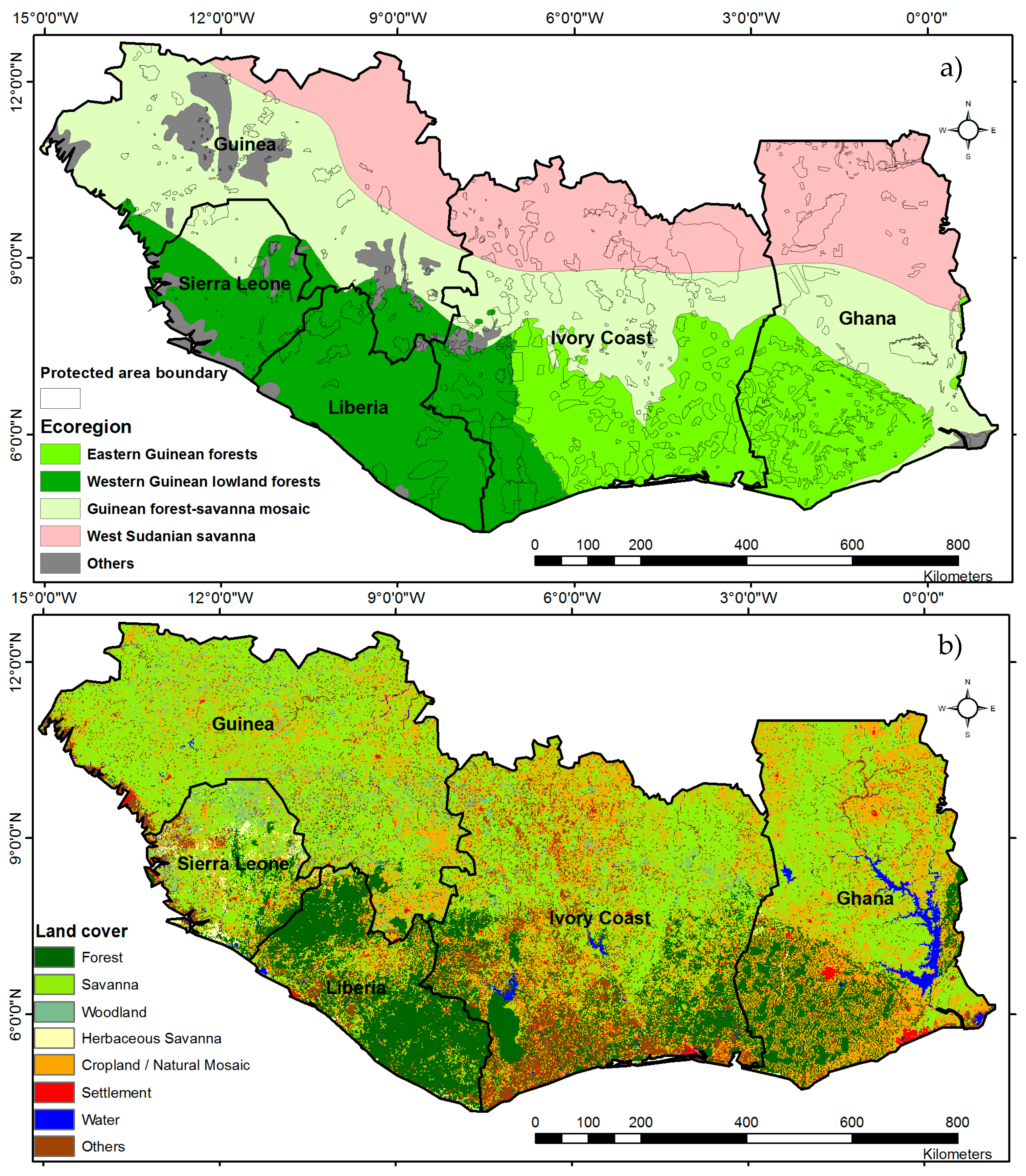
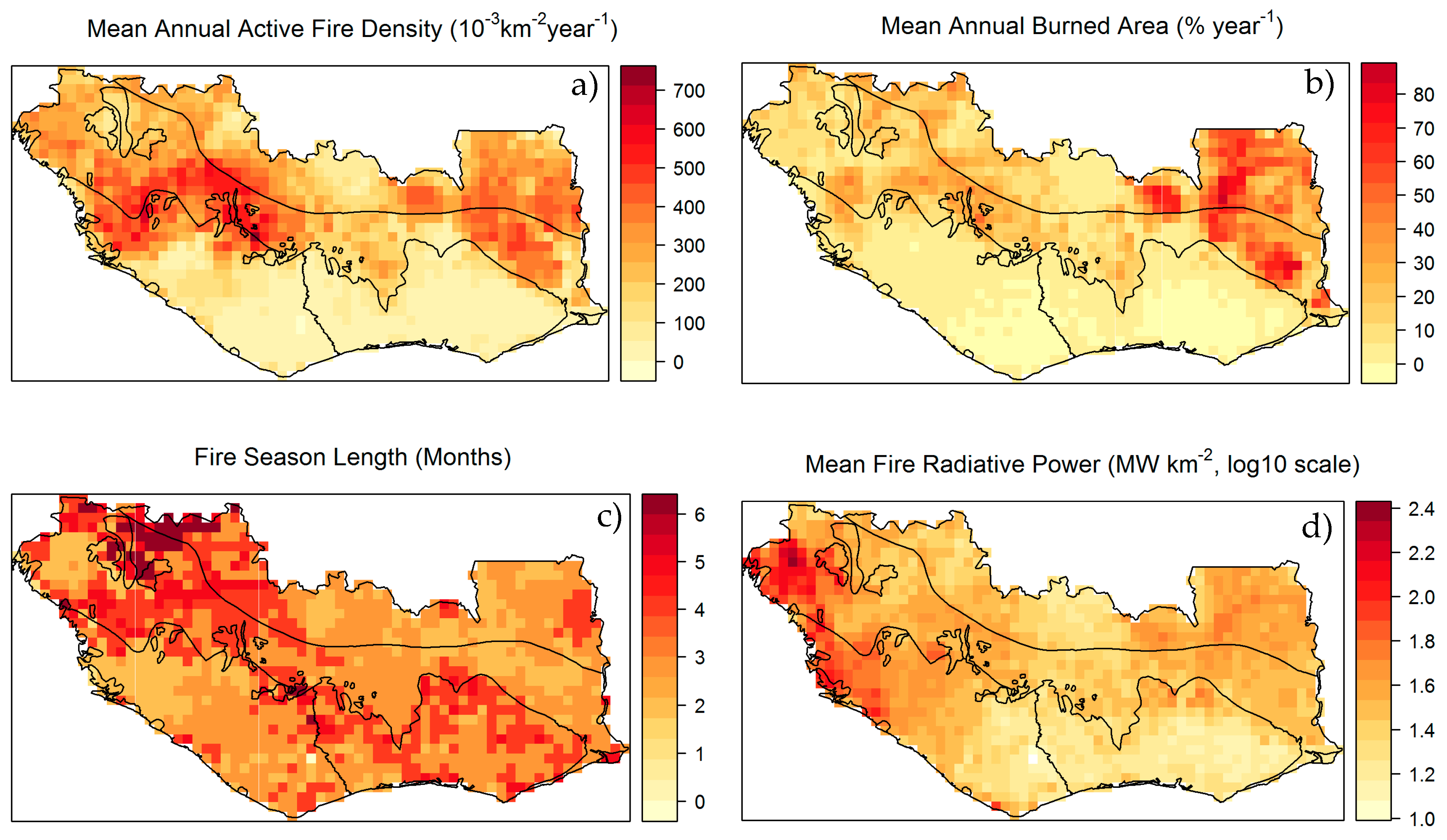
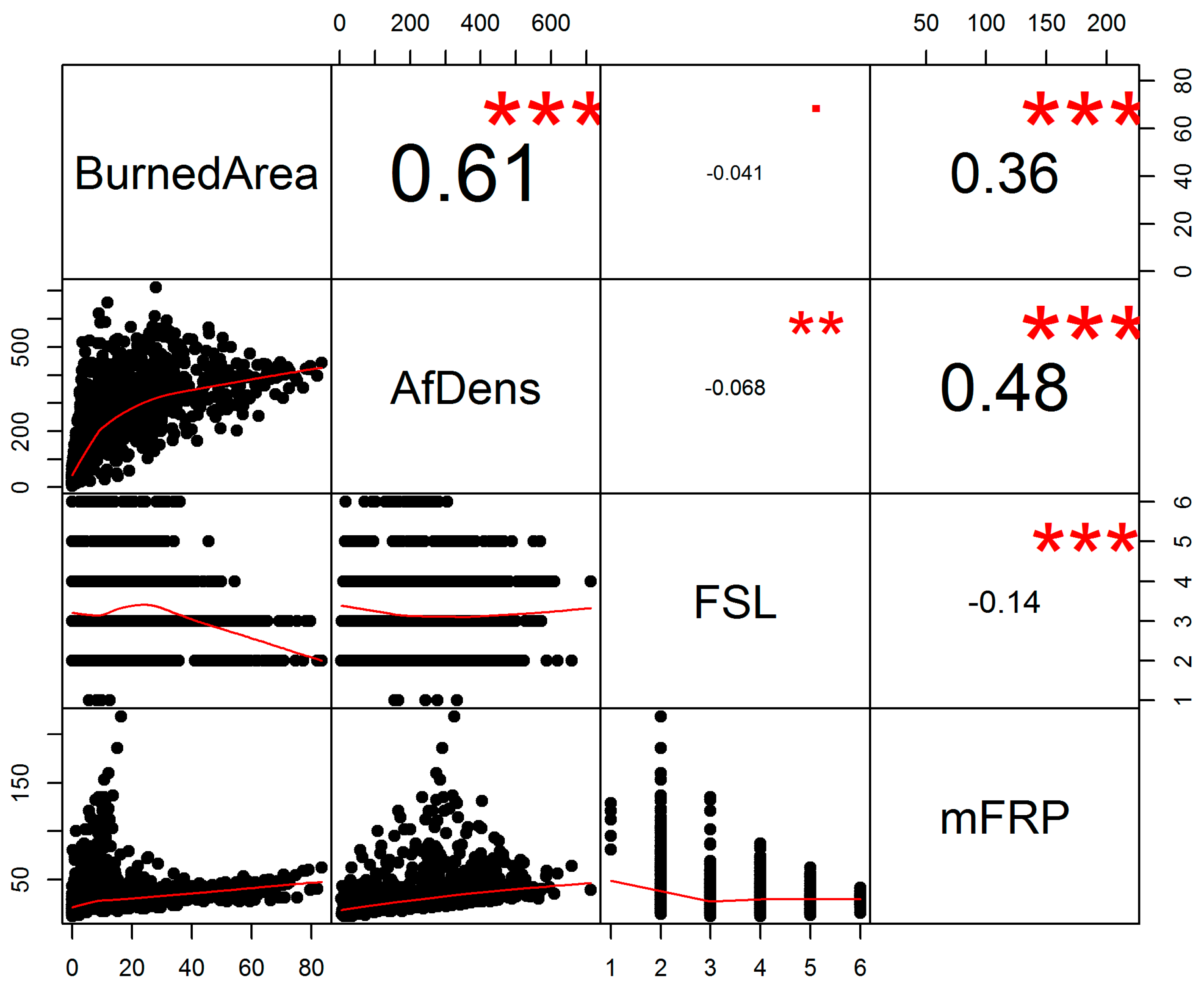
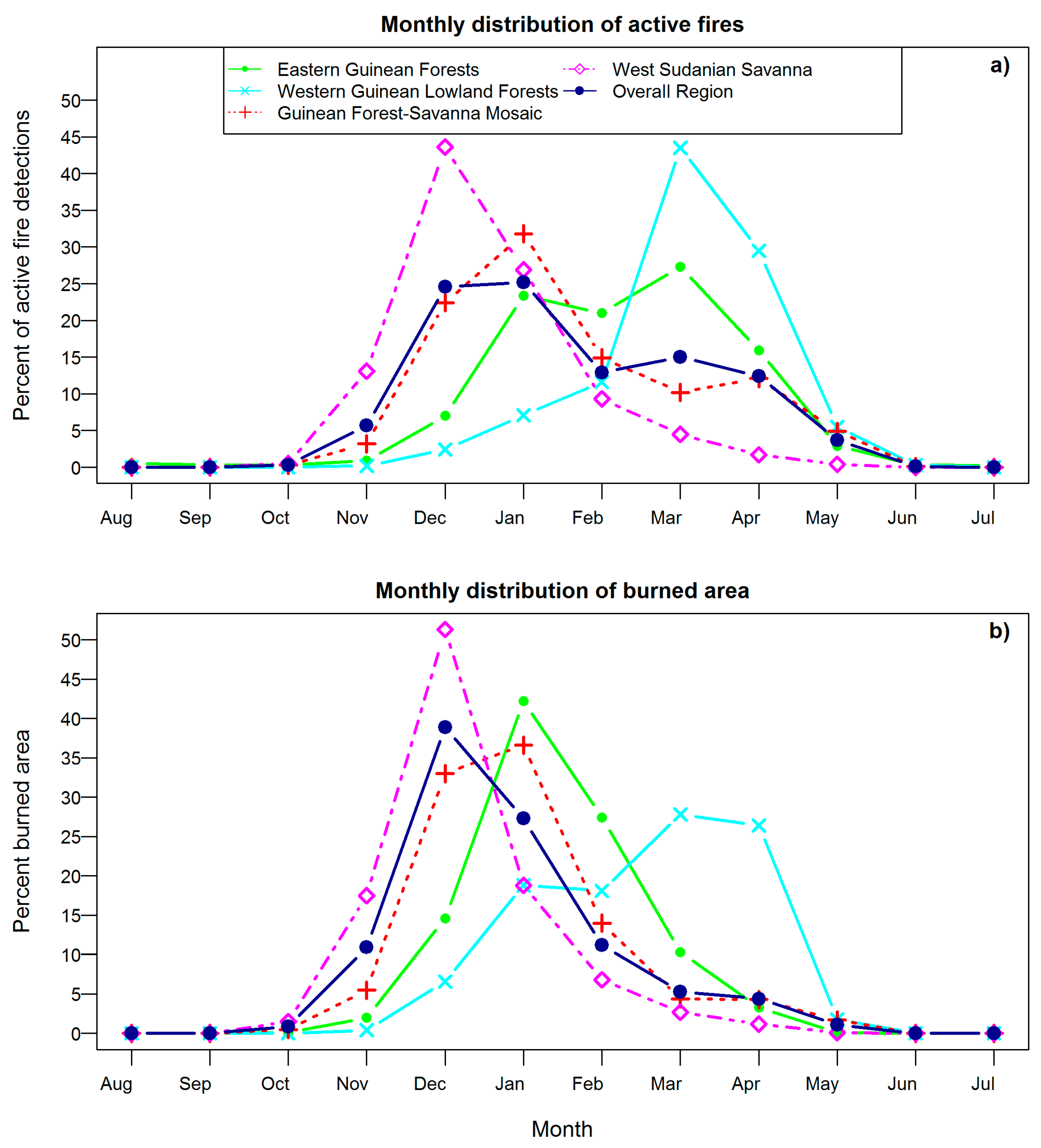
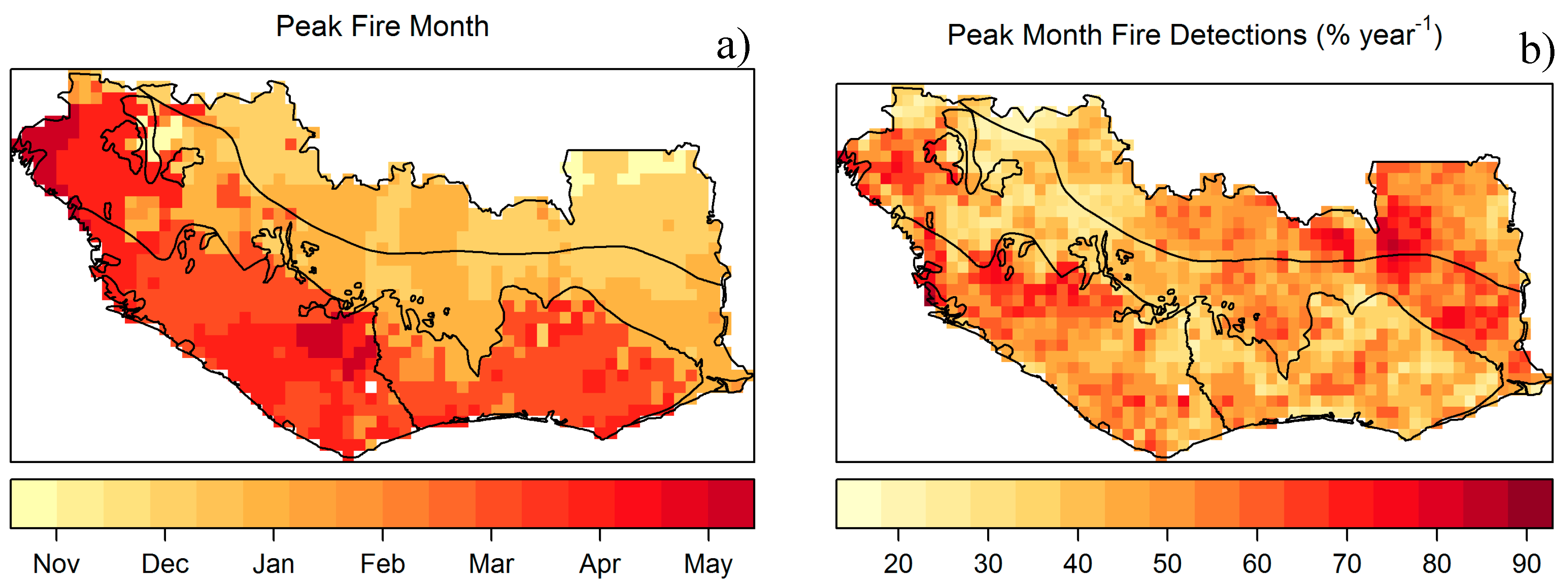
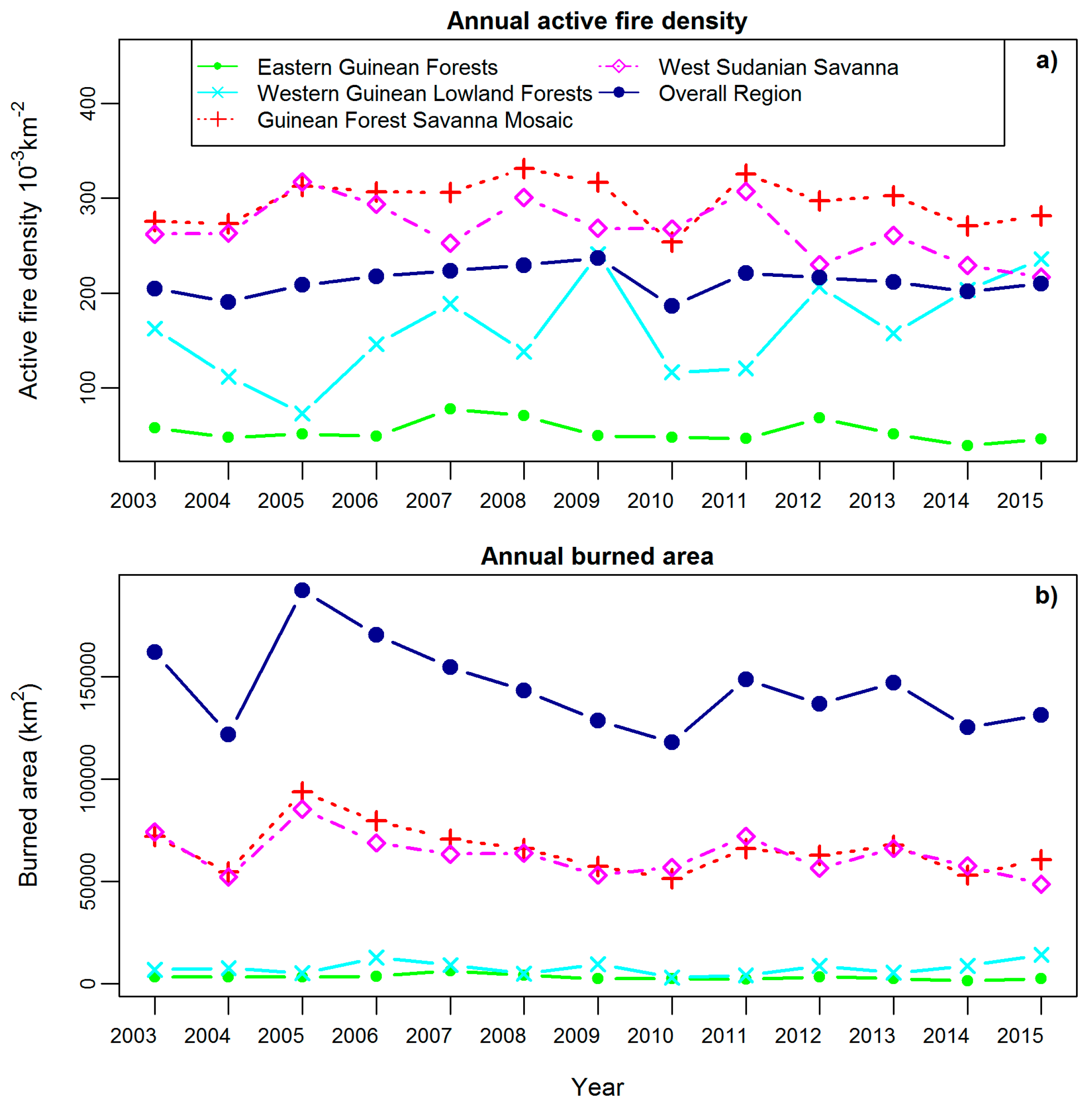
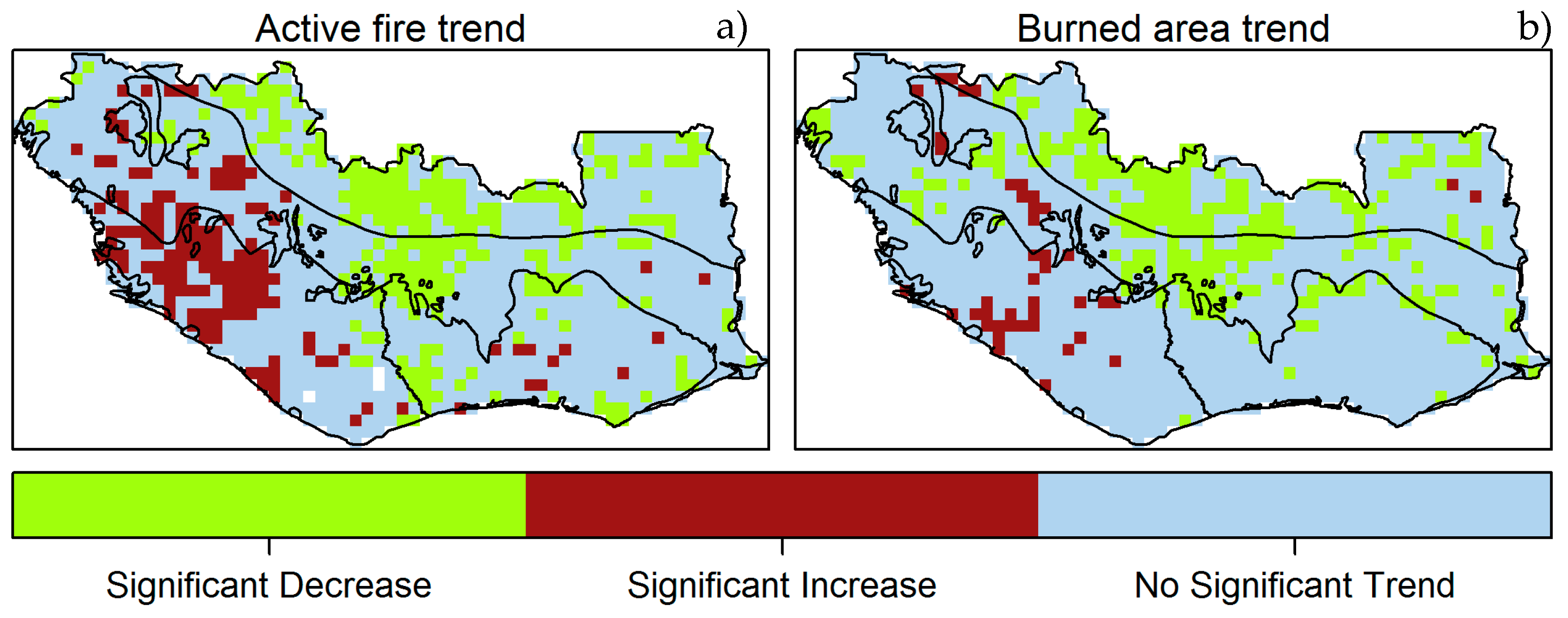
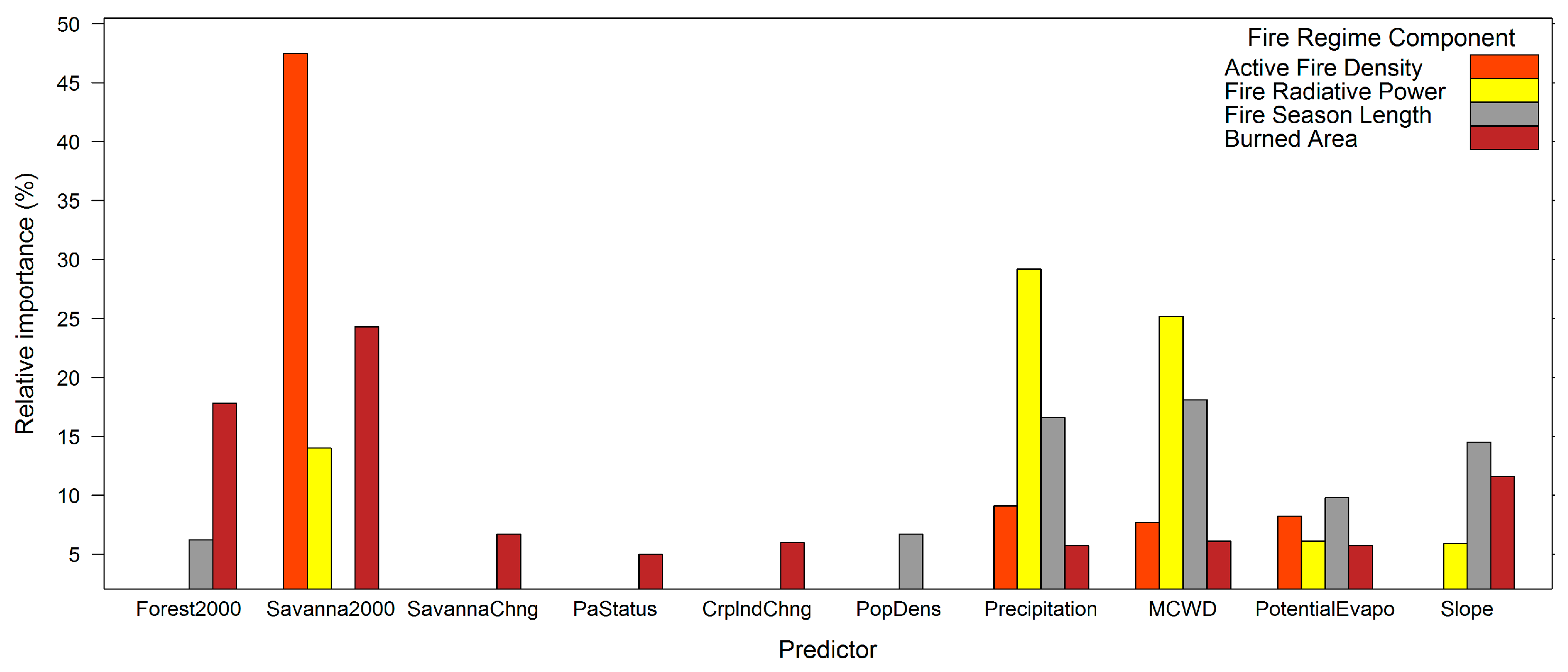

| Data Layer | Sources and Description | Variable Name (Units) |
|---|---|---|
| Fire variables | ||
| Active Fire Density | Mean annual fire density for 2003–2015 derived from 1 km monthly MODIS active fire product MCD14ML collection 6 [24] | AfDens (fires 10−3 km−2 year−1) |
| Fire Radiative Power | Mean fire radiative power per pixel of active fire detections for 2003–2015 derived from MCD14ML collection 6 | mFRP (MW km−2) |
| Fire Season Length | Length of the active fire period for 2003–2015 generated from MCD14ML collection 6 | FSL (months/year) |
| Burned Area | Mean annual burned area for 2003–2015, as a percent of grid cell area, generated from 500 m monthly Burned Area product MCD64A1 Collection 6 [30] | BurnedArea (% year−1) |
| Predictor variables | ||
| Vegetation | ||
| Forest cover 2000 | Proportion of grid cell covered by forest in 2000, derived from 2 km resolution USGS land cover map [6] | Forest2000 (%) |
| Forest Change | Change in proportion of forest between 2000 and 2013 (generated from [6]) | ForestChng (%) |
| Savanna cover 2000 | Proportion of grid cell covered by savanna in 2000, derived from USGS land cover map [6] | Savanna2000 (%) |
| Savanna Change | Change in proportion of savanna between 2000 and 2013 (generated from [6]) | SavannaChng (%) |
| Protected Area Status | IUCN Protected Categories System [39] | PaStatus: 1: Production-Reserve (PR), 2: Eco-Reserve (ER), 3: Non-protected (NP) |
| Climate | ||
| Mean Annual Precipitation | Mean annual precipitation for 2003–2015, derived from Tropical Rainfall Measuring Mission (TRMM) monthly product 3B43-v7 [40] | Precipitation (mm/year) |
| Mean Annual Cumulative Water Deficit | Mean annual maximum cumulative water deficit for 2003–2015, calculated from TRMM product 3B43-v7 | MCWD (mm/year) |
| Potential Evapotranspiration | Global Aridity Index & Potential Evapo-Transpiration Climate Database, ≈1 km resolution [37] | PotentialEvapo (mm/year) |
| Human | ||
| Population Density | Population density in 2010 generated from Gridded Population of the World (GPWv4), ≈1 km resolution from CIESIN (Center for International Earth Science Information Network—Columbia University, 2015) | PopDens (persons/km2 log10 scale) |
| Distance to Road | Euclidean distance to major roads (functional class 0–3), derived from Global Roads Open Access Data Set [38] | Dist2Road (km log10 scale) |
| Cropland 2000 | Proportion of grid cell covered by cropland/agriculture in 2000, generated from USGS land cover map [6] | Crplnd2000 (%) |
| Cropland Change | Change in proportion of cropland between 2000 and 2013, generated from USGS land cover map [6] | CrplndChng (%) |
| Distance to Cropland | Euclidean distance to cropland in 2000, generated from USGS land cover map [6] | Dist2Crplnd (km) |
| Topography | ||
| Slope | Slope from ≈90 m resolution SRTM DEM [41] | Slope (degrees) |
| Fire Regime Metric | Western Guinean Lowland Forests (WGLF) | Eastern Guinean Forests (EGF) | Guinean Forest Savanna Mosaic (GFSM) | West Sudanian Savanna (WSS) |
|---|---|---|---|---|
| Annual Active Fire Density (fires 10−3 km−2 year−1) | 162 ± 51 | 54 ± 11 | 297 ± 24 | 267 ± 31 |
| Percent Annual Burned Area (% year−1) | 3.8 ± 1.6 | 1.8 ± 0.7 | 21.2 ± 3.8 | 27.2 ± 4.5 |
| Fire Season Length (months) | 2.9 ± 0.8 | 3.4 ± 0.7 | 3.3 ± 1.0 | 3.2 ± 0.9 |
| Fire Radiative Power (MW km−2) | 47 ± 79 | 23 ± 34 | 42 ± 86 | 34 ± 44 |
| Fire Regime Metric | Statistic | Western Guinean Lowland Forests | Eastern Guinean Forests | Guinean Forest Savanna Mosaic | West Sudanian Savanna |
|---|---|---|---|---|---|
| Annual Active Fire Density | Tau | 0.359 | −0.333 | −0.103 | −0.385 |
| p-value | 0.1 * | 0.127 | 0.669 | 0.077 * | |
| Annual Burned Area | Tau | 0.077 | −0.333 | −0.359 | −0.308 |
| p-value | 0.76 | 0.127 | 0.1 * | 0.161 |
© 2017 by the authors. Licensee MDPI, Basel, Switzerland. This article is an open access article distributed under the terms and conditions of the Creative Commons Attribution (CC BY) license (http://creativecommons.org/licenses/by/4.0/).
Share and Cite
Dwomoh, F.K.; Wimberly, M.C. Fire Regimes and Their Drivers in the Upper Guinean Region of West Africa. Remote Sens. 2017, 9, 1117. https://doi.org/10.3390/rs9111117
Dwomoh FK, Wimberly MC. Fire Regimes and Their Drivers in the Upper Guinean Region of West Africa. Remote Sensing. 2017; 9(11):1117. https://doi.org/10.3390/rs9111117
Chicago/Turabian StyleDwomoh, Francis K., and Michael C. Wimberly. 2017. "Fire Regimes and Their Drivers in the Upper Guinean Region of West Africa" Remote Sensing 9, no. 11: 1117. https://doi.org/10.3390/rs9111117




